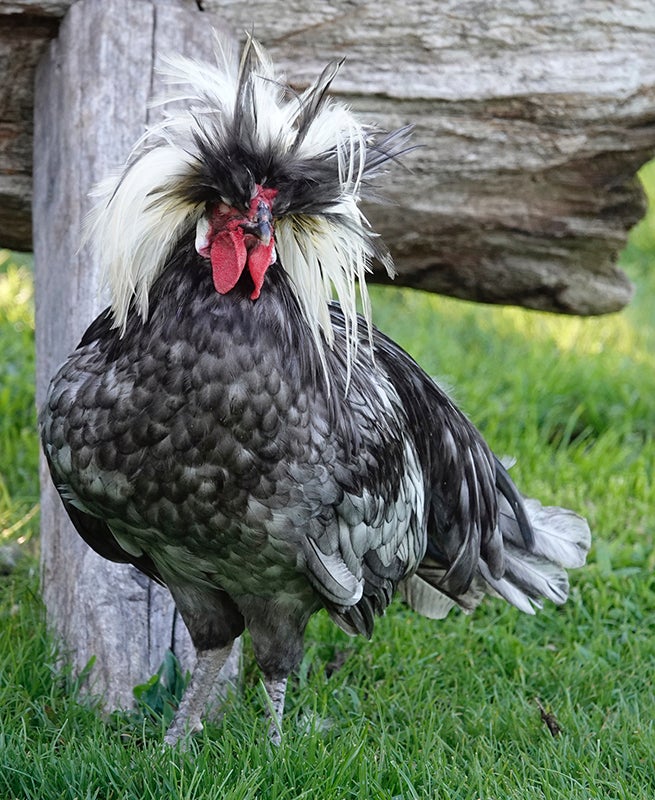Al Batt: Winter weather great for conversation, but less so for pheasants
Published 9:00 am Saturday, March 9, 2019

This rooster — both a bird and a crested Polish chicken — fell asleep while on sentry duty. Al Batt/Albert Lea Tribune
Al Batt of Hartland is a member of the Albert Lea Audubon Society. Email him at SnoEowl@aol.com.
The guy from just down the road
My neighbor Crandall stops by.
“How are you doing?” I ask.
“Everything is nearly copacetic. Winter has caused me to have a glove in every pocket and to walk as if I have an egg in each shoe. My memories are clogged with a lifetime of nasty winters. All the snow shoveling I’ve done is paying off. I’ve lost several ounces. I sprained a toe kicking a hitchhiker. The hitchhiker wasn’t a person. It was that hard slush buildup in the wheel well of my truck. I’ve tried winter on for size. It’s too big for me. The most common thing I heard in February was, ‘It’s still snowing!’ I have to get up earlier than I want to just to get snow put in its proper place. I trick myself. I set my alarm clock in my bedroom to a movie trailer loudness. I set the clock in the bathroom five minutes earlier than the clock in the bedroom. The clock in the living room is five minutes earlier then the clock in the bathroom. The clock in the kitchen is set for five minutes earlier than the one in the living room. And my wrist watch is five minutes earlier than that. So, by the time I get outside, I’m 20 minutes ahead of schedule.”
Naturally
The blue jays were talkative. Mark Twain wrote, “You never saw a bluejay get stuck for a word. He is a vocabularized geyser.”
A snowplow grumbled by. It sounded tired. I was happy to see it. February was cold, but its warm sunlight melted snow. It had given itself plenty of snow to melt. “Light tomorrow with today!” said Elizabeth Barrett Browning.
Freed from home by the snowplow’s good work, I drove around entertaining my camera. Most of the miles were on rural roads, some gravel and some hard surface. The snow gave a soft wind visibility. I saw more bald eagles than cows. How times have changed. You could say I drove the wrong roads, but it’s what I saw.
Brandon Brackey of Albert Lea and I talked about the weather. It’s hard not talking about the weather. Brandon is an avid pheasant hunter and is concerned about the survival of the birds over our harshest season. The loss of food due to a persistent cover of snow and/or ice is a killer. Waste grain, an important food source, becomes unavailable under a deep accumulation of snow. I read once that 300 kernels of corn per day would maintain a pheasant’s weight. Captive pheasants have been able to survive several weeks without food, but they don’t expend energy avoiding predators and staying warm. A healthy wild pheasant could go at least three days without food. The annual survival rate of ring-necked pheasants is around 50 percent. Hens are more likely to succumb to starvation than are roosters, as the females enter winter in poor condition due to the high energy demands of nesting and rearing chicks. Strong winds can sometimes be beneficial to pheasants as they might free feeding areas of snow. Another problem for pheasants is the lack of suitable winter cover.
Q&A
“Are common buckthorn berries harmful to birds?” I couldn’t find any research indicating that they are toxic to birds. I’ve read that they are in many articles, but unearthed nothing in studies to back that up. Buckthorn is invasive and outcompetes native plant species. It defines hardiness.
Jerry Viktora of Ellendale asked about the fall behavior of turkeys. Birds of a feather flock together. Hens flock with other hens, including female offspring that might no longer roost in the same trees as their
Batt
Continued fron Front Page
mothers. Hens that were unsuccessful in nesting might form smaller flocks with other lone hens. Toms form their own flocks, often segregated by age. Young males, called jakes, band together. Flocks rarely interact with others. The mature toms that flock together in the winter, separate when the breeding season commences in the spring.
“What is the heaviest owl I might see in Minnesota?” The snowy owl is North America’s heaviest owl on average.
“Which is larger, a bald eagle or a golden eagle?” There are variances in the sizes of individual birds in both species, but generally, they are the same size.
“Is there enough water in Lake Superior to cover the United States?” According to the World Atlas, Lake Superior holds enough water to cover all the land of North and South America in a foot of water. Lake Superior has 10 percent of the world’s surface fresh water.
Thanks for
stopping by
“The older I get, the greater power I seem to have to help the world; I am like a snowball — the further I am rolled the more I gain.“ — Susan B. Anthony
“A seed hidden in the heart of an apple is an orchard invisible.” — Welsh Proverb
Do good.



